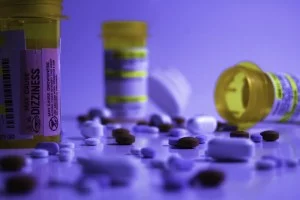It is unfortunate that there are people who think prescribed drugs are completely safe, simply because the doctor said so. While this way thinking is not a problem per se, it becomes a big one when these prescription drugs are used cavalierly, backed up by the wrong idea that a doctor’s say-so is enough to prove they are completely safe to be used any way you want. Doctor’s prescriptions come with specific dosages and instructions, and going beyond them is courting disaster, just like you would be if you are actually taking hard and illicit drugs like heroin and ice.
12 Reasons Why Prescription Drug Abuse Is More Dangerous than Illicit Drug Abuse

The decades-old War on Drugs has successfully driven into our heads that illicit drugs like cocaine, heroin and ice are society’s worst enemy, and are therefore the most dangerous of all. What many don’t realise, however, is that there’s a group of even more dangerous drugs, and all one needs to buy them is a doctor’s prescription.
That’s right: Prescription drug abuse is more dangerous than illicit drug abuse. In Australia, the ice epidemic may be hogging the headlines, but according to the Australian Medical Association (AMA), prescription drug abuse is killing more people. In fact, says the AMA, prescription drug abuse is a national emergency already.
Why is prescription drug abuse more dangerous than illicit drug abuse? Listed below are 12 reasons, some of which may come as a complete surprise.

1. Prescription drugs can be bought legally
As previously stated, prescription drugs can be legally bought as long as one presents a doctor’s prescription for them. That in itself is not a problem, because some people do need these medications, particularly those who are in a kind of pain that only stronger painkillers like fentanyl and oxycodone can effectively deal with. The problem here would be abuse, if the patient takes more of the painkillers and in even bigger doses than what the doctor prescribed.
2. Prescription drug addiction is often the end result of abuse
There are many kinds of prescription medication, and some of the most widely-used are opioids such as fentanyl and oxycodone. However, not too many people know that opioids are basically pharmaceutical-grade heroin legally produced in a laboratory, and that makes them as highly addictive as their illegal cousins being sold in the streets. Opioid abuse can easily become an opioid addiction, and with prescription drug addiction comes a host of other bigger problems.
3. Most abused prescription drugs can be bought online without prescription
The thing with prescription drugs is that they are highly regulated, and these regulations state that it would be illegal to purchase them without a doctor’s prescription. That, however, is not a problem with the Internet. Do a search for “no prescription online pharmacy”, and you’ll see a host of websites that are only too willing to sell you any prescription drug you want, without a doctor’s say-so.

4. Prescription medicine bought online can be fake
It’s bad enough that legally manufactured and sold prescription drugs pose a risk to one’s health when they’re misused or abused. What makes things worse is that prescription medicine bought online can be counterfeit, loaded with a mixture of ingredients that could severely hurt or even kill the people who take them.
5. Prescribed drugs are safer, or so people think
6. Prescribed medication and cocaine have something in common
What do Xanax, Oxycontin, cocaine and opium have in common? They are all listed as Schedule 8 drugs in Australia. This means they all have a high potential for abuse, and that abusing them may lead to severe physical or psychological dependence.
7. Abuse prescription drugs and you’re abusing very potent ones
Many of the synthetic drugs available as prescription medication have very high potency, and this creates a high overdose risk. One such drug is Zohydro, an opioid analgesic. According to a CNN report, Zohydro is five times more potent than most prescription drugs on the market.
8. Prescription medication blamed for many drug overdose deaths
Earlier this year, a Victoria coroner told attendees at a medical conference in Melbourne that of the 384 overdose deaths investigated by the Victorian coroner’s court in 2014, prescription drugs are involved in 82% of those deaths. This isn’t really a surprise because, as mentioned in the previous item, many prescription drugs really do pack a potent punch.

9. Prescription medication abuse leads to accidents
Sedation is one of the most common reactions of taking prescription drugs, opioids in particular. This shouldn’t be a problem if the person taking the painkiller is at home resting in bed. However, being up and about while on the opioid could spell disaster. Driving and operating heavy machinery at work, for instance, could easily turn deadly if the person behind the machine is impaired by prescription drugs. You can only imagine how much worse it’s going to be if the person actually abuses those drugs. It also needs to be said that prescription drug abuse can also be hard to detect even for on-site drug testing measures, and that’s why employers need to take a closer look at this problem.
10. Addiction to painkillers has many adverse effects on one’s health
Of the many types of prescription drugs, narcotic painkillers are the most addictive owing to their heroin-like properties. They make a person feel no pain, sedated and euphoric. Unfortunately for that person, he or she will also be experiencing nausea, vomiting, constipation, itching, slurred speech, confusion, and shallow or slow breathing. They are also prone to long-term damage to muscle tissue and other vital organs such as the heart, liver and kidneys.
11. Prescription drug abuse could lead to dangerous drug interactions
Technically, all drugs could interact with other drugs. The danger of adverse interactions for prescription drugs, however, is even worse. This is to be expected, considering that the ingredients of prescription drugs are often more potent than over-the-counter (OTC) drugs. To make things worse, there are people who mix prescription drugs and alcohol, a rather dangerous combination if there ever was one.
Our very own Heath Ledger is a prime example for the deadly effects of adverse drug interactions. The Oscar-winning actor died after taking a deadly mix of oxycodone, hydrocodone, diazepam, temazepam, alprazolam and doxylamine.
12. Painkiller addiction is becoming common in Australia
This is basically driving home the earlier point that prescription drug abuse and addiction is already a national emergency. According to the United Nations 2014 World Drug Report, Australia ranks second in the use of opioids such as codeine and morphine. Given the highly addictive nature of opioids, it wouldn’t be surprising that many Aussies are already suffering from painkiller addiction.
The government’s campaign against ice is laudable, but our authorities should realise how deadly (or even deadlier) prescription drug abuse is becoming in Australia. Prescription drug abuse in Australia is a problem that needs to be addressed, since it is already proving to be worse than illicit drug abuse. Employers also need to take steps like Drug-Safe induction programs to educate their workforce on the downsides of prescription drug abuse.
Discover More
Safework Health is a national provider of occupational health and safety services. We specialise in instant drug and alcohol testing, laboratory drug testing, drug and alcohol courses and policy development.
Ask us how we can help keep your workplace safe from the dangers of prescription medication.
